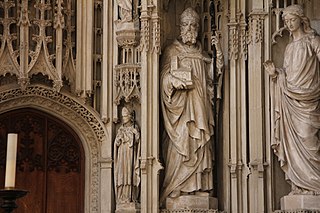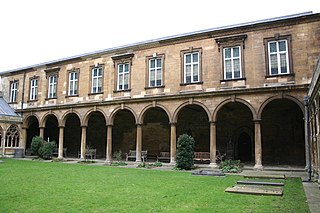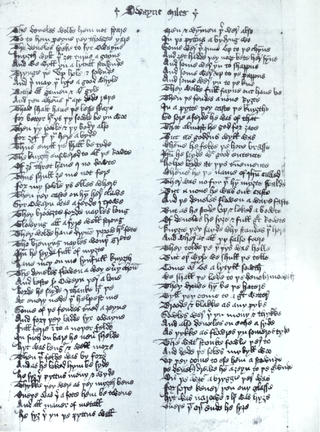Related Research Articles

Le Morte d'Arthur is a 15th-century Middle English prose reworking by Sir Thomas Malory of tales about the legendary King Arthur, Guinevere, Lancelot, Merlin and the Knights of the Round Table, along with their respective folklore. In order to tell a "complete" story of Arthur from his conception to his death, Malory compiled, rearranged, interpreted and modified material from various French and English sources. Today, this is one of the best-known works of Arthurian literature. Many authors since the 19th-century revival of the legend have used Malory as their principal source.
Constantine was a 6th-century king of Dumnonia in sub-Roman Britain, who was remembered in later British tradition as a legendary King of Britain. The only contemporary information about him comes from Gildas, who castigated him for various sins, including the murder of two "royal youths" inside a church. The historical Constantine is also known from the genealogies of the Dumnonian kings, and possibly inspired the tradition of Saint Constantine, a king-turned-monk venerated in Southwest Britain and elsewhere.

St Erkenwald is a fourteenth-century alliterative poem in Middle English, perhaps composed in the late 1380s or early 1390s. It has sometimes been attributed, owing to the Cheshire/Shropshire/Staffordshire Dialect in which it is written, to the Pearl poet who probably wrote the poems Pearl, Patience, Cleanness, and Sir Gawain and the Green Knight.
Huchoun, Huchown or Huchowne "of the Awle Ryale" is a poet conjectured to have been writing sometime in the 14th century. Some academics, following the Scottish antiquarian George Neilson (1858–1923), have identified him with a Scottish knight, Hugh of Eglinton, and advanced his authorship of several significant pieces of alliterative verse. Current opinion is that there is little evidence to support this.
The Alliterative Morte Arthure is a 4346-line Middle English alliterative poem, retelling the latter part of the legend of King Arthur. Dating from about 1400, it is preserved in a single copy in the 15th-century Lincoln Thornton Manuscript, now in Lincoln Cathedral Library.

The Lincoln Cathedral Library is a library of Lincoln Cathedral in Lincolnshire, England. It is housed in a building designed by Christopher Wren.
Robert Thornton was a Yorkshire landowner, a member of the landed gentry. His efforts as an amateur scribe and manuscript compiler resulted in the preservation of many valuable works of Middle English literature, and have given him an important place in its history.
The Awntyrs off Arthure at the Terne Wathelyne is an Arthurian romance of 702 lines written in Middle English alliterative verse. Despite its title, it centres on the deeds of Sir Gawain. The poem, thought to have been composed in Cumberland in the late 14th or early 15th century, survives in four different manuscripts from widely separated areas of England.
The Alliterative Revival is a term adopted by literary historians to refer to the resurgence of poetry using the alliterative verse form in Middle English between c. 1350 and 1500. Alliterative verse was the traditional verse form of Old English poetry; the last known alliterative poem prior to the Revival was Layamon's Brut, which dates from around 1190.

Octavian is a 14th-century Middle English verse translation and abridgement of a mid-13th century Old French romance of the same name. This Middle English version exists in three manuscript copies and in two separate compositions, one of which may have been written by the 14th-century poet Thomas Chestre who also composed Libeaus Desconus and Sir Launfal. The other two copies are not by Chestre and preserve a version of the poem in regular twelve-line tail rhyme stanzas, a verse structure that was popular in the 14th century in England. Both poetic compositions condense the Old French romance to about 1800 lines, a third of its original length, and relate “incidents and motifs common in legend, romance and chanson de geste.” The story describes a trauma that unfolds in the household of Octavian, later the Roman Emperor Augustus, whose own mother deceives him into sending his wife and his two newborn sons into exile and likely death. After many adventures, the family are at last reunited and the guilty mother is appropriately punished.

Sir Eglamour of Artois is a Middle English verse romance that was written sometime around 1350. It is a narrative poem of about 1300 lines, a tail-rhyme romance that was quite popular in its day, judging from the number of copies that have survived – four manuscripts from the 15th century or earlier and a manuscript and five printed editions from the 16th century. The poem tells a story that is constructed from a large number of elements found in other medieval romances. Modern scholarly opinion has been critical of it because of this, describing it as unimaginative and of poor quality. Medieval romance as a genre, however, concerns the reworking of "the archetypal images of romance" and if this poem is viewed from a 15th-century perspective as well as from a modern standpoint – and it was obviously once very popular, even being adapted into a play in 1444 – one might find a "romance [that] is carefully structured, the action highly unified, the narration lively."
The Knightly Tale of Gologras and Gawain is a Middle Scots Arthurian romance written in alliterative verse of 1362 lines, known solely from a printed edition of 1508 in the possession of the National Library of Scotland. No manuscript copy of this lively and exciting tale has survived.
The Erl of Toulouse is a Middle English chivalric romance centered on an innocent persecuted wife. It claims to be a translation of a French lai, but the original lai is lost. It is thought to date from the late 14th century, and survives in four manuscripts of the 15th and 16th centuries. The Erl of Toulouse is written in a north-east Midlands dialect of Middle English.
Sir Degrevant is a Middle English romance from the early fifteenth century. Generally classified as a "composite romance," that is, a romance that does not fit easily into the standard classification of romances, it is praised for its realism and plot. The poem is preserved in two manuscripts along with a variety of secular and courtly texts, one of which was compiled by the fifteenth-century scribe Robert Thornton. It is notable for its blending of literary material and social reality.
The Prose Life of Alexander is a Middle English prose romance extant in a single copy, found in the mid-fifteenth century Lincoln Thornton Manuscript. It was edited by J. S. Westlake for the Early English Text Society.
The London Thornton Manuscript is a medieval manuscript compiled and copied by the fifteenth-century English scribe and landowner Robert Thornton. The manuscript was long considered a miscellany, but is more properly called a collection of spiritual texts.

The Harley Lyrics is the usual name for a collection of lyrics in Middle English, Anglo Norman, and Latin found in Harley MS 2253, a manuscript dated ca. 1340 in the British Library's Harleian Collection. The lyrics contain "both religious and secular material, in prose and verse and in a wide variety of genres." The manuscript is written in three recognisable hands: scribe A, scribe B or the Ludlow scribe, and scribe C.
The StanzaicMorte Arthur is an anonymous 14th-century Middle English poem in 3,969 lines, about the adulterous affair between Lancelot and Guinevere, and Lancelot's tragic dissension with King Arthur. The poem is usually called the Stanzaic Morte Arthur or Stanzaic Morte to distinguish it from another Middle English poem, the Alliterative Morte Arthure. It exercised enough influence on Thomas Malory's Le Morte d'Arthur to have, in the words of one recent scholar, "played a decisive though largely unacknowledged role in the way succeeding generations have read the Arthurian legend".
Thorlac Francis Samuel Turville-Petre is an English philologist who is Professor Emeritus and former head of the School of English at the University of Nottingham. He specializes in the study of Middle English literature.

The Pearl Manuscript, also known as the Gawain manuscript, is an illuminated manuscript produced somewhere in northern England in the late 14th century or the beginning of the 15th century. It is one of the best-known Middle English manuscripts, the only one containing alliterative verse solely, and the oldest surviving English manuscript to have full-page illustrations. It contains the only surviving copies of four of the masterpieces of medieval English literature: Sir Gawain and the Green Knight, Pearl, Cleanness, and Patience. It has been described as "one of the greatest manuscript treasures for medieval literature", and "the most famous of all romance manuscripts".
References
- Notes
- 1 2 3 Brewer and Owen vii.
- 1 2 Whetter 46.
- 1 2 McIntosh 336.
- ↑ Brewer and Owen ix.
- ↑ Brewer and Owen viii.
- 1 2 Thompson, "Another Look" 169.
- ↑ Lethbridge 144-46.
- 1 2 Dutton 18.
- ↑ Brewer and Owen xvii-xx.
- ↑ Fein 224.
- ↑ McVaugh 542.
- ↑ Fredell 78-79.
- ↑ Fredell 80-87.
- ↑ Fredell 87-88.
- ↑ Thompson.
- ↑ Keiser.
- ↑ Chappell 1.
- ↑ Johnston.
- ↑ Brewer and Owen x-xi.
- Bibliography
- Brewer, Derek S.; Owen, A.E.B. (1977). The Thornton Manuscript (Lincoln Cathedral MS.91). London: The Scolar Press. ISBN 0-85967-352-9.
- Chappell, Julie (1992). The prose Alexander of Robert Thornton: the Middle English text with modern English translation. Peter Lang. ISBN 978-0-8204-1508-6.
- Dutton, Elisabeth M. (2008). Julian of Norwich: the influence of late-medieval devotional compilations. Boydell & Brewer. ISBN 978-1-84384-181-4.
- Fein, Susanna Greer (1989). "'Haue Mercy of Me' (Psalm 51): An Unedited Alliterative Poem from the London Thornton Manuscript". Modern Philology . 86 (3): 223–41. doi:10.1086/391701.
- Fredell, Joel (1994). "Decorated Initials in the Lincoln Thornton Manuscript". Studies in Bibliography . 47: 78–88.
- Gibbs, A.C. (1966). Middle English Romances. Evanston: Northwestern UP. pp. 136–58.
- Horstmann, Carl (1895–1896). Yorkshire Writers: Richard Rolle of Hampole, an English Father of the Church, and his Followers. London: Swan, Sonnenschein & Co.
- Johnston, Michael (2007). "A New Document Relating to the Life of Robert Thornton". The Library: The Transactions of the Bibliographical Society . 8 (3): 304–13. Retrieved 2 April 2011.
- Keiser, George (1983). "The Nineteenth-Century Discovery of the Thornton Manuscript (Lincoln Cathedral Library MS 91)". Papers of the Bibliographical Society of America. 77 (2): 167–90.
- Lethbridge, J.B. (2006). Edmund Spenser: new and renewed directions. Fairleigh Dickinson UP. ISBN 978-0-8386-4066-1.
- McIntosh, Angus (1939). "Rev. of The Liber de diversis medicinis". The Review of English Studies . 15 (59): 336–38. JSTOR 509801.
- McVaugh, Michael R. (1971). "Rev. of The Liber de diversis medicinis" (PDF). Isis . 62 (4): 542. doi:10.1086/350815.
- Ogden, Margaret Sinclair (1938). The 'Liber de diversis medicinis' in the Thornton Manuscript. Early English Text Society. Vol. 207. London: Oxford UP.
- Thompson, John J. (1994). "Another look at the religious texts in Lincoln, Cathedral Library, MS 91". In Alistair J. Minnis (ed.). Late-medieval religious texts and their transmission: essays in honour of A.I. Doyle. Boydell & Brewer. ISBN 978-0-85991-386-7.
- Thompson, John J. (1987). Robert Thornton and the London Thornton manuscript: British Library MS Additional 31042. D.S. Brewer. ISBN 978-0-85991-190-0.
- Whetter, Kevin Sean (2008). Understanding genre and medieval romance. Ashgate. ISBN 978-0-7546-6142-9.